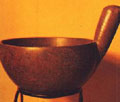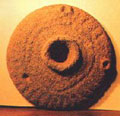Guanche Customs
 The clothing used by the natives were mainly tanned skins from goats or sheep, called Tamarcos.
The clothing used by the natives were mainly tanned skins from goats or sheep, called Tamarcos.
The Canary wrestling, a game sport, is a sport from Guanche origin, and was an important component of the Beñesmén festivities and in the present day has a special place among the people of Tenerife.
The game of the Canary stick has its origin in the fights and games with sticks of the Canary aborigines and has been kept up to our days, passing from masters to students.
Gofio , a kind of basic food in the Guanche diet, is a kind of flour made from barley, corn or ground roasted wheat, to which water was added or goat’s milk. Today this food is treasured by the older folk, mainly due to its energetic effects.
Some of the ancient dances and chants appear today in the religious festivities, the names of some dances such as the “tajaraste”, the “tanganillo” or the “saltonas” directly proceed from the Guanches.
 The decorative pottery and personal adornment crafts materialises in the bead necklaces and in the famous “pintaderas”, a kind of iconographic Guanche symbol that consists of an intertwining of triangles inside another triangle; the spiral is yet another dominating Guanche symbol.
The decorative pottery and personal adornment crafts materialises in the bead necklaces and in the famous “pintaderas”, a kind of iconographic Guanche symbol that consists of an intertwining of triangles inside another triangle; the spiral is yet another dominating Guanche symbol.
The Guanche calendar started on the 21st of June and they called their year Acano, it was divided into twelve moons with a duration of twenty nine suns from the new moon, the names of these moons were as follows:
Month of the Young Sun or first moon (June July)
Month of the honey harvest or second moon (July- August)
 Month of the Beñesmer or third moon (August-September) festivity of the Beñesmer, an important festivity in the agricultural calendar of the Guanches, it is celebrated after the harvest of the crops (August 15 th is the date on which the Beñesmer is celebrated, the cult to the Goddess Chaxiraxi).
Month of the Beñesmer or third moon (August-September) festivity of the Beñesmer, an important festivity in the agricultural calendar of the Guanches, it is celebrated after the harvest of the crops (August 15 th is the date on which the Beñesmer is celebrated, the cult to the Goddess Chaxiraxi).
Month of Pasture or fourth moon (September –October)
Month of the Warm Sun or fifth moon (October –November)
Month of the Baifo or sixth moon (November December)
Month of the Old Sun or seventh moon (December -January)
Month of the Light or eighth moon (January -February)
Month of the Green or ninth moon (February -March)
Month of the Magek or tenth moon (March – April)
Month of the Tinnit (Chaxiraxi, a Guanche goddess, that after the colonisation became the Virgin of Candelaria) or eleventh moon (April -May)
Month of the fruits or twelfth moon (May -June)
The main celebrations were weddings, king’s coronations (Menceyes), war deeds and past events, implorations to the gods, as well as the harvest of the crops at the beginning of the year. The festivities of the crop sowing times consisted of different rituals practiced through out nine days.
The festivity of the Beñesmer, an important date in the Guanches agricultural calendar after the harvest dedicated to the Chaxiraxi (August 15th is the date of the Beñesmer celebration, the cult to the Goddess Chaxiraxi) in this festivity the Guanches share their milk, gofio, goat’s meat or sheep’s meat (very precious foods for the Guanches).
Today this festivity coincides with the pilgrimage to the basilisk of the Virgin of Candelaria. After the colonisation, there was a syncretism between the Goddess Chaxiraxi and the Virgin of Candelaria, their celebration is held on February 2 nd, although August 15 th is when their apparition is celebrated. The celebration of the Guanche New Year was also absorbed by the Festivity of San Juan.
Among the cultural celebrations, there are significant traces of aborigine traditions in the present day festivities, such as the Pilgrimage of Socorro (Romería del Socorro), in Güímar, the festivity of the Virgin of Candelaria, the Festivity of the Corpus (Fiesta del Corpus), in the Valley of La Orotava, the “Poleo” in Icod de los Vinos and the Festivity of San Juan.
After the colonisation, the celebrations were divided between those of official character and the popular ones, linked almost always to religious purposes. The official festivities were organised at La Laguna, which after the colonisation became the capital of Tenerife.